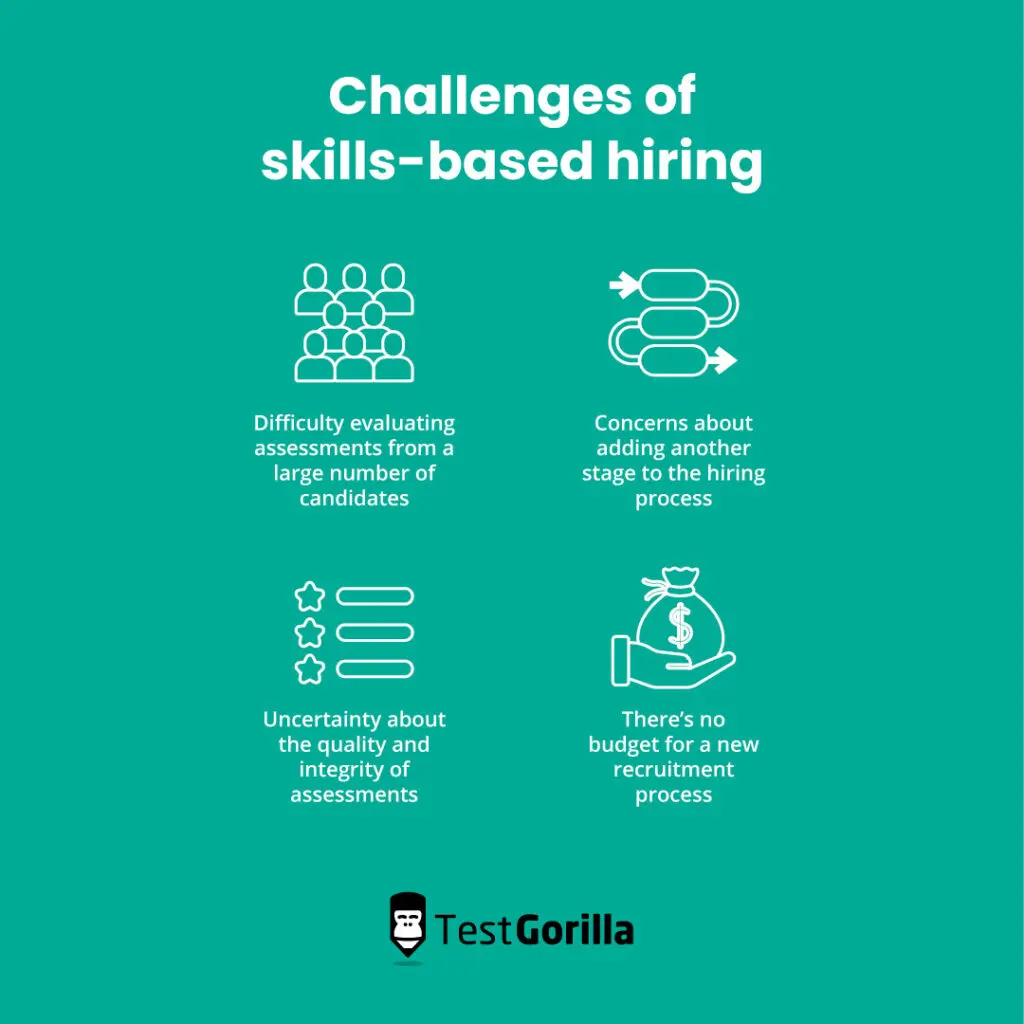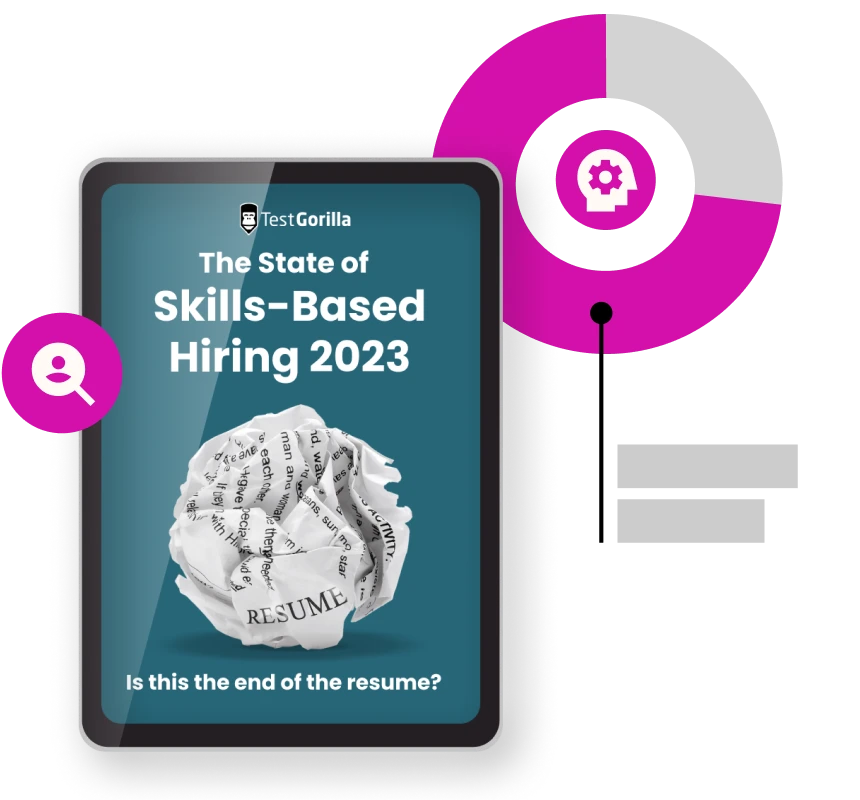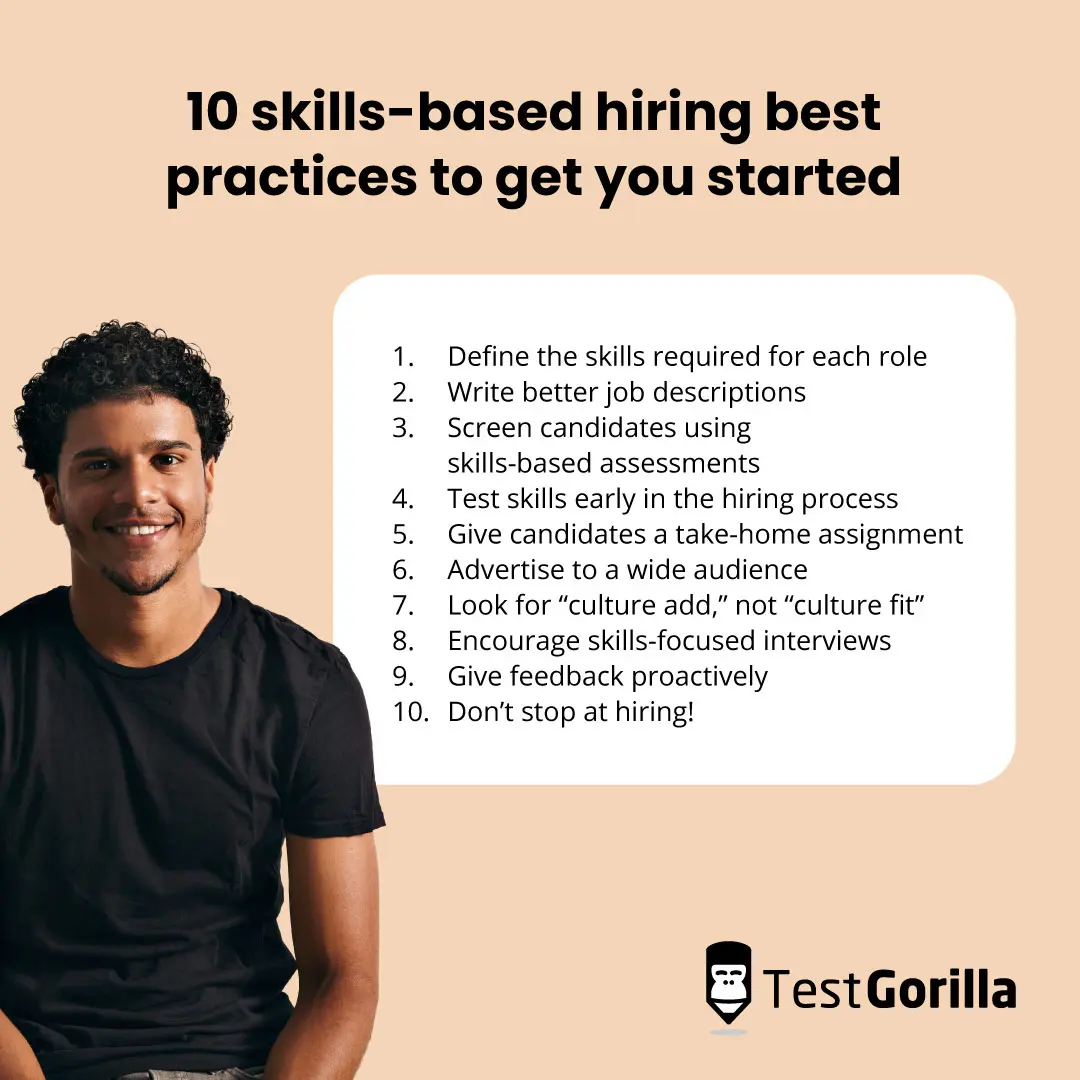10 best practices to adopt skills-based recruitment and selection processes
Our 2023 State of Skills-Based Hiring report reveals that both hiring teams and candidates are increasingly dissatisfied with ineffective and unfair traditional recruitment practices.
But hiring methods are changing. We found that 76% of companies are already embracing skills-based hiring. The best part? Candidates hired in this way are happier in their roles, stay longer, and perform better.
We know skills-based hiring increases hiring ROI while reducing time-to-hire and employee churn. But we’re no strangers to its challenges either since we practice what we preach in our own organization. That’s why we’ve put together 10 best practices to help you get started with skills-based recruitment and selection.
Table of contents
- 4 common objections to skills-based recruitment and selection practices
- 5 benefits of adopting skills-based recruitment and selection practices
- 10 best practices for adopting a skills-based recruitment and selection process
- Find the best talent by using skills-based practices in recruitment and selection
4 common objections to skills-based recruitment and selection practices
There are all kinds of barriers to trying out a new process – like finding the budget for it in the first place. Before we dive into best practices, let's go through some of the most common objections to skills-based hiring, clear them up, and offer some solutions.
1. Reliability of results
Some employers still doubt the quality and integrity of skills-based assessments. In other words, you don’t know how well these tests actually measure candidates’ abilities.
Doubts about the effectiveness of skills tests can be a barrier. Yet, the evidence in our 2023 report shows organizations that adopt skills-based hiring practices can significantly reduce mis-hires and lead to more satisfied, higher-performing employees.
Plus, we’re our own best case study – our skills-based hiring process has offered continuous proof that this method results in happier, higher-performing employees.
Another key piece of data is that resumes are incredibly unreliable. Resume statistics show that:
43% of employers say they find it difficult to rank candidates using resumes
43% of employers say they struggle to determine an applicant’s skills from their resume
51% of employers say they struggle to determine whether the resumes of their applicants are accurate
92% of employers agree or strongly agree that skills-based hiring is more effective at identifying talented candidates than resumes
89% of employers believe that skills-based hiring is more predictive of on-the-job-success than resumes
Hopefully, that's enough to convince you, or any other stakeholders in your hiring process, that skills-based selection practices are more reliable than resume-based ones.
2. It’s difficult to evaluate assessments from a big candidate pool
Many HR professionals face the hurdle of processing a high volume of applications. This challenge is compounded when traditional hiring practices, like resume screening, are used.
34% of employers say they receive too many resumes to read
Evaluating a high volume of assessments isn't the same as screening a high volume of resumes. Employers can use the automated scoring systems and analytics provided by TestGorilla to shortlist candidates quickly.
What's more, with TestGorilla, employers can send an assessment to as many candidates as they like without incurring extra costs. In sum, skills-based selection approaches ensure that employers with large hiring pools only spend time with their top candidates. It actually makes it easier to evaluate a large pool of applicants.
3. Why add another stage to the hiring process?
Lengthy hiring processes can cost your company revenue, productivity, and even top-tier candidates. Among the employers we surveyed, skills-based hiring raises concerns about adding more stages to the hiring process.
The key here is not to approach skills-based hiring as an additional stage but rather as a replacement for other processes, like resume screening. In this way, skills-based hiring results in a more efficient, streamlined process overall.
In addition, most job applicants see skills-based hiring as a good thing; most of them are happy to complete extra steps if it means the hiring process is fairer and more objective.
According to The State of Skills-Based Hiring 2023, 86% of candidates agree or strongly agree they are more likely to secure their dream job when given the chance to prove they have the right skills for the role.
The State of Skills-Based Hiring 2023
Read TestGorilla's annual report to discover why over 70% of companies chose to adopt skills-based hiring methods in 2023.
4. There’s no budget for a new recruitment process
The initial investment in creating a new recruitment process can be daunting. However, in the long run, skills-based hiring can lead to higher ROI through reduced hiring times and lower employee turnover.
For example, when you adopt skills-based hiring, you actually reduce the time spent screening applications and are more likely to find talented candidates. This means reduced employee churn and higher hiring ROI and productivity in the long run.
74% of employers using skills-based hiring reduced cost-to-hire
Read about how LILAB boosts new employee retention up to 90% with TestGorilla
Read about how TestGorilla helped Gardenvity reduce recruitment costs by up to 80%
5 benefits of adopting skills-based recruitment and selection practices
Employers gain several key benefits when you adopt skills-based hiring practices:
Improved hiring quality: Focusing on skills rather than resumes leads to more accurate matches between candidates and job requirements, enhancing overall job performance.
Reduced hiring bias: Skills-based assessments offer an objective approach, reducing unconscious biases and promoting a diverse workforce.
Streamlined recruitment process: By quickly identifying qualified candidates through skill assessments, the recruitment process becomes more efficient, saving time and resources.
Increased employee retention: Hiring candidates well-suited to their roles based on skills leads to higher job satisfaction and, consequently, better retention rates.
Access to a wider talent pool: By not limiting candidates based on education or background, skills-based hiring opens opportunities to a broader array of talent.
These benefits highlight the effectiveness of skills-based hiring in creating a more dynamic, skilled, and diverse workforce.
10 best practices for adopting a skills-based recruitment and selection process
HR professionals’ concerns about adopting skills-based hiring tend to center on efficiency, effectiveness, and budget. With these concerns in mind, we’ve put together a list of 10 skills-based hiring best practices you can apply in your organization.
1. Define the skills required for each role
Real talent doesn’t come down to whether or not someone has a college degree. Skills are far more important.
Take Revolut, the mobile banking app. To reach a global user base, it needed multilingual support staff. Julia Panchenko, the services recruitment manager at Revolut, says the company was facing major challenges with all the “extra manual work” required to manage written and verbal language checks.
Since she knew language skills were fundamental to the role, it made sense to create an automated screening process based on language proficiency. This helped her improve time-to-hire by 30% to 40%.
To define the important skills for your vacancy:
Start by speaking to the hiring manager. They’ll be able to list the practical skills used in the role. Make sure the list is specific enough, e.g., “using content tools like Sprout to schedule social media posts” rather than “marketing.”
Practice “skills ontology.” This refers to understanding the skills a candidate needs for a specific role and measuring the relationships between those skills. This lets you create a common language and understanding of the skills you need across various roles.
Think about soft skills. Hard skills are practical requirements like “using Node.js to develop software.” Soft skills are personal attributes like the “ability to solve problems under time pressure.”
Categorize skills as “required” or “acquired.” Certain skills are needed before the job starts (required), but others can be learned later (acquired). Separating the two will help you make better hiring decisions.
Add transferable skills. Otherwise, you could miss a talented person whose resume doesn’t show a typical career trajectory. For example, a former high school teacher could have the public speaking and organizational skills to suit a role in events management.
Ask, “How will they prove it?” All the required skills for a role should be measurable. Certification isn’t always the best proof of skill, so consider how adopting a skills-based test or assessment might help you screen candidates.
2. Write better job descriptions
We like to think that education is a meritocracy, but the truth is it’s just as prone to bias as hiring can be. If your job descriptions state that applicants need a certain level of education, you’ll shut out a wide pool of talent simply because they don’t have the privilege of having a college degree.
Fewer employers are making this mistake than ever before. In 2020, the number of job ads on LinkedIn that didn’t require a degree increased by nearly 40%.
To modernize your hiring process and create a more diverse workforce, write a job description template focusing on the ideal candidate’s skills and values.
Here’s how:
Focus on responsibilities over requirements. This is the secret to attracting a wide talent pool. Job descriptions that describe the tasks an employee will face on a regular basis are likely to get more applications per view.
List any other important skills. Again, don’t forget soft skills like empathy or teamwork. This will help candidates understand what’s expected of them.
Add the necessary qualifications. Skip this step if degrees, certifications, or licenses aren’t a hard requirement. Otherwise, you could add a note about any required work samples or skills assessments here.
Show them why they should apply. Think about what makes this role appealing, what learning and career development opportunities there are, and what elements of your company culture to display.
Do a final edit. Snappy job descriptions are the way to go since most applicants won’t spend more than a few seconds skimming through them. Cut any language that might discourage women or minorities from applying – better yet, get a second opinion from your diversity and inclusion officer.
3. Screen candidates using talent assessments
When it comes to screening applicants, talent assessments are your biggest ally. Whether you choose a technical skills assessment or behavioral test, the idea is to get an objective score to accurately reflect competency and reduce hiring bias.
One example is TruTrip, a business travel management company whose new hires’ skills weren’t meeting the organization’s needs. TruTrip swapped a resume-focused screening process and instead chose to adopt pre-employment assessments, which helped them shortlist candidates who were a much better fit.
Hugh Batley, the founder of TruTrip, said, “[New hires] become great contributors more quickly and, importantly, they appear to have a better initial experience with us.”
Pro tip: Before you overhaul your entire hiring process, pick a vacancy that needs your attention urgently. For example, start with a role that has a high turnover rate and could do with a boost in employee retention. Then, look for a skills test that suits the role.
4. Test skills early in the hiring process
Introducing your skills test at the top of the hiring funnel will help you make fast, bias-free decisions and create a shortlist of suitable talent rather than wading through resumes.
To bring skills-based testing in early:
Shortlist the most crucial skills. There may be some skills that are essential to the role. These are the ones to test for right at the beginning of your application process. For example, if using the React Native framework is a core responsibility, you could screen all applicants using a React Native test before you even look at a resume.
Pick a relevant assessment. You could build your own or choose from a library of pre-built tests. You can also mix and match tests from different categories, like language proficiency, soft skills, and personality tests.
Create an automated process. If the first step of the process is to screen applicants based on a test, use your applicant tracking system (ATS) to trigger an automated email to the hiring manager that includes the test results of the best-scoring candidates.
Send an assessment to all of your applicants. With TestGorilla, you can send a talent assessment to as many candidates as you like without incurring extra costs. Using talent assessments at the start of the hiring funnel is the most effective way to use skills-based hiring.
5. Give candidates a take-home assignment
Similar to a skills-based assessment, a take-home assignment is an opportunity for candidates to show how they approach a specific task in a more realistic scenario. We found this is the second most popular type of skills-based hiring after role-specific tests.
For example, if you’re hiring a graphic designer, you could give them a creative brief for an ad campaign. Give the designer one week to complete the task using your company’s typical software and processes.
When the task is complete, they’ll present the campaign while you ask questions to evaluate their creativity, attention to detail, and ability to follow processes.
The benefit of take-home assessments is that you can evaluate the approach as well as the results and skills used, so even less experienced candidates may get an opportunity to shine if they’re a great match for the role.
Note that reviewing take-home assignments is time intensive so should be reserved for a shortlist of candidates. This is why we suggest using talent assessments first.
6. Advertise your job opening to a wide audience
Before Digital Care started using skills testing, job openings were only ever advertised via the chief executive officer’s LinkedIn profile. Social media is a handy tool for sharing job ads, but it doesn’t get you much further than a few immediate connections.
Now, Digital Care posts on career websites and uses skills assessments to screen applications. So, even though far more applications come in, the hiring team actually saves time (and money) by only focusing on the best candidates.
Advertise on a mix of social media channels and job sites to reach the widest possible audience. When the applications roll in, use your ATS to organize applicants, easily search by key terms or application status, and automate stages of the hiring process.
7. Look for “culture add,” not “culture fit”
It’s trendy right now for companies to rave about their internal culture. That’s understandable: Disengaged employees can cause internal conflict and reduce overall productivity.
But hiring someone you think will “fit in” is problematic. Firstly, recruiters often get organizational culture or values confused with whether or not the candidate would be “up for beers” after work. Secondly, it reinforces existing biases and reduces someone’s ability to do a job to whether or not they share the same hobbies or interests as their team.
It's good practice to hire for “culture add” over “culture fit”, because it focuses on what the candidates can bring to the table rather than how they fit into the existing culture.
You’ll see organizations like Netflix and Zoom embodying this idea. Netflix’s famous company culture includes values like “judgment, communication, curiosity, innovation, inclusion, integrity, impact, and passion.”
Meanwhile, Eric Yuan, the chief executive officer of Zoom Video Communications, has said that he looks for hires with diverse experiences who can bring new ideas and fresh thinking to each team.
Here’s how you can do the same:
Define the values of your organization. What makes your business tick? How do you differentiate yourself? It’s important for all employees to understand your company’s values so that they can fulfill the expectations of their role.
Don’t confuse values with ideas. Candidates need to share the values of the organization, such as being low ego or solutions-oriented. But that doesn’t mean that they can’t have different ideas or backgrounds.
Be inclusive. Hiring for “culture add” means looking past whether someone has a specific degree or goes skiing every February. Instead, look for anyone who shares the company values, even if they have their own perspectives. This kind of diversity will result in a more dynamic, creative workforce.
Compare candidates objectively. You need a bias-free way to compare candidates without discriminating. Many businesses have started using assessments that include culture-add tests to make more quantifiable comparisons.
8. Conduct skills-focused interviews
Before you begin interviewing, build a scoring rubric that clearly defines what constitutes a good answer to each question. This will help reduce subjective judgments and give your interviewers robust guidance on best practices for skills-focused interviews.
Make sure to design your interview questions to reveal the skills you’re looking for. For example, situational questions (like “Tell me about a time you’ve disagreed with an important client. How did you handle it?”) help evaluate the candidate’s values and behaviors in certain scenarios.
Dropping in some unexpected questions will show how a candidate processes information in real-time.
Take Apple or Google. The stereotype is that big tech teams ask off-piste, impossible interview questions. The reality is that companies like Apple use interviews to measure skills and potential over qualifications or experience. They hire based on soft skills like work ethic or problem-solving and provide plenty of training on the job.
This approach is also attractive to potential employees, who will feel more fulfilled in roles with the right learning and development opportunities.
Drawn-out interview processes can be off-putting to job seekers and a resource drain on hiring teams.
9. Give feedback proactively
People talk. Any dissatisfaction with your hiring process is bound to affect your organization’s reputation and could also damage morale.
Proactively offering constructive interview feedback will ensure candidates feel more valued and help them understand your reasoning. Our blog on adopting constructive interview feedback practices is a good read if you want to learn more about the topic.
To improve your hiring feedback process:
Favor progress over perfection. Don’t expect any candidate to ace every part of the application. Look for the person who meets the core requirements but also has the capacity to grow and learn in the role.
Use measurable criteria. Encourage hiring managers to refer to the interview scoring rubric and any objective scores obtained from skills-based tests. This will help them make informed decisions and formulate useful feedback afterward.
Be specific. Where possible, use specific examples to give candidates a clear sense of what to improve on.
Automate if time is short. The most constructive feedback is always personalized, so send a personal email to anyone who made it through to the interview stage. For those who didn’t, it’s acceptable to send an automated response. To make it more personalized and offer constructive feedback, you could include their skills test scores.
Invite mutual feedback. Both your applicants and current team members should get the opportunity to give feedback on the hiring process. Use the results to improve the testing process for next time.
10. Don’t stop at hiring!
The final part of skills-based hiring is what comes next: growth. To get long-term benefits out of skills-based selection processes, your company needs a continuous culture of professional and personal growth. And this should be skills-based, too.
Learning and development opportunities are the second biggest priority for Gen Z and millennial job seekers after a good work/life balance.
To build skills-based practices into professional growth and learning and development:
Prepare personalized onboarding. Plan 6 to 12 months of onboarding for each role. It helps to have a template for this, but the best onboarding plans are customized to meet each employee’s skill and experience level.
Create learning opportunities. Every employee should get the chance to gain new skills, but don’t put the responsibility entirely on them to seek this out. Build a process for identifying employees for reskilling and upskilling.
Carry out regular performance reviews. Getting regular feedback makes employees feel valued and gives them benchmarks for success. These reviews don’t have to be intimidating, formal meetings (although it does help to have standardized ways to measure performance). Instead, you can use them as collaborative sessions for mutual feedback and development planning.
Find the best talent by using skills-based practices in recruitment and selection
Want to become more competitive by hiring the right people for the job?
Skills-based hiring creates a more diverse, productive workforce and boosts hiring ROI. Sign up for your free TestGorilla plan and learn how easy it is to start creating skills assessments.
Download the 2023 State of Skills-Based Hiring report to learn more about how businesses benefit from adopting skills-based hiring practices.
Related posts
Hire the best candidates with TestGorilla
Create pre-employment assessments in minutes to screen candidates, save time, and hire the best talent.
Latest posts
The best advice in pre-employment testing, in your inbox.
No spam. Unsubscribe at any time.

Hire the best. No bias. No stress.
Our screening tests identify the best candidates and make your hiring decisions faster, easier, and bias-free.
Free resources
This checklist covers key features you should look for when choosing a skills testing platform
This resource will help you develop an onboarding checklist for new hires.
How to assess your candidates' attention to detail.
Learn how to get human resources certified through HRCI or SHRM.
Learn how you can improve the level of talent at your company.
Learn how CapitalT reduced hiring bias with online skills assessments.
Learn how to make the resume process more efficient and more effective.
Improve your hiring strategy with these 7 critical recruitment metrics.
Learn how Sukhi decreased time spent reviewing resumes by 83%!
Hire more efficiently with these hacks that 99% of recruiters aren't using.
Make a business case for diversity and inclusion initiatives with this data.




















